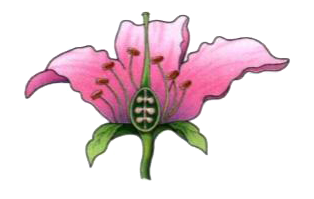In which of the following plants, the margin of thalamus grows further upward completely enclosing the ovary and getting fused it and bears the sepals, petals and stamens above the ovary?
Possessing meiosis to form haploid spores that rise to gemetophyte
Absence of an independent free-living gametophytic stage in life cycle
Presence of seeds without seed coat
Possessing compactly arranged micro sporophylls to form female cones
To solve the question regarding which plant has a thalamus that grows upward to completely enclose the ovary, we need to understand the concept of flower structure and types of flowers.
1. Understanding Flower Structure:
- Flowers consist of several parts: sepals, petals, stamens, and the ovary. The arrangement of these parts around the ovary can vary.
2. Types of Flower Arrangement:
- There are two main types of flower arrangements based on the position of the ovary:
- Hypogynous: The ovary is situated above the attachment of other floral parts (sepals, petals, stamens).
- Perigynous: The ovary is at the same level as the other floral parts, which are attached to a cup-like structure called the hypanthium.
- Epigynous: The ovary is completely enclosed by the thalamus, which grows upward and fuses with it, placing the sepals, petals, and stamens above the ovary.
3. Identifying the Correct Type:
- The question specifically describes a flower where the thalamus grows upward to enclose the ovary. This is characteristic of epigynous flowers.
4. Examples of Epigynous Flowers:
- Common examples of plants with epigynous flowers include:
- Apple (Malus domestica)
- Pear (Pyrus)
- Cucumber (Cucumis sativus)
- Tomato (Solanum lycopersicum)
5. Conclusion:
- Based on the description provided in the question, the correct answer is the plant that exhibits epigynous flower characteristics. Therefore, the answer is option number 4, which refers to plants with compactly arranged microsporophylls forming female cones.
- Flowers consist of several parts: sepals, petals, stamens, and the ovary. The arrangement of these parts around the ovary can vary.
- There are two main types of flower arrangements based on the position of the ovary:
- Hypogynous: The ovary is situated above the attachment of other floral parts (sepals, petals, stamens).
- Perigynous: The ovary is at the same level as the other floral parts, which are attached to a cup-like structure called the hypanthium.
- Epigynous: The ovary is completely enclosed by the thalamus, which grows upward and fuses with it, placing the sepals, petals, and stamens above the ovary.
- The question specifically describes a flower where the thalamus grows upward to enclose the ovary. This is characteristic of epigynous flowers.
- Common examples of plants with epigynous flowers include:
- Apple (Malus domestica)
- Pear (Pyrus)
- Cucumber (Cucumis sativus)
- Tomato (Solanum lycopersicum)
- Based on the description provided in the question, the correct answer is the plant that exhibits epigynous flower characteristics. Therefore, the answer is option number 4, which refers to plants with compactly arranged microsporophylls forming female cones.
Topper's Solved these Questions
Similar Questions
Knowledge Check
In __________flowers, margin of thalamus grows upward enclosing the ovary completely and getting fused with it.
AhypogynousBperigynousCepigynousDBoth (b) and (c)
If position of ovary is below sepals petals and stamens, the flower is called
View Solutionwhich of the following plants bear flowers with variation in the length of filaments of stamens?
View SolutionIn which of the following aestivation, sepal/ petal's one margin covers the other and its second margin is covered by previous one ?
View SolutionThalamus grows to enclose ovary and other parts arise above the ovary in condition
View SolutionWhich one of the following plants has ovary superior, monocarpellary and unilocular with several ovules on marginal placenta ?
View SolutionLabel the following parts in the given diagram .
thalamus , style , stigma , sepals , petals , stamens

View SolutionName the group of plants in which seeds are not enclosed in an ovary.
View Solution
